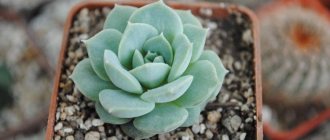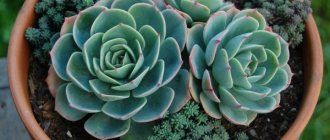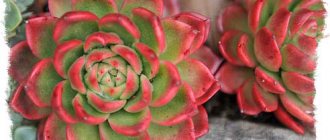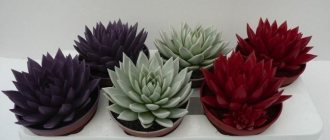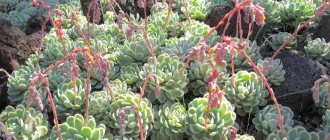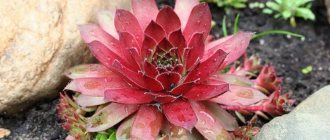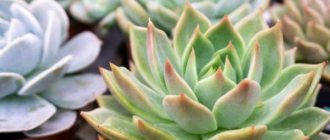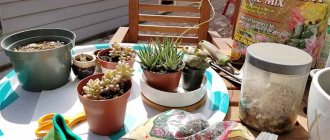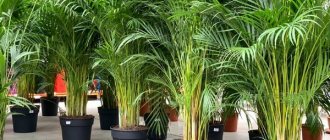The desert succulent Echeveria is a perennial, herbaceous plant belonging to the Crassulaceae family. In the homeland of the exotic flower, more than 170 subspecies are known, which differ in color, leaf shape, height and flowering.
The indoor succulent acquired its official name thanks to the artist Atanasio Echeverría y Godoy, who was engaged in illustrating books about nature. In some countries, the succulent is compared to flowering plants and is called "stone rose", echeveria or "stone flower".
Description
Most types of echeveria have dense, fleshy leaves that are collected in rosettes. The diameter of the rosettes, depending on the variety, is from 3 to 43 cm. The height of an adult succulent is from 4 to 15 cm.
The leaf blades can be colored soft green, blue-gray, reddish, dark green, pale blue, pinkish-violet, burgundy or soft purple.
The shape of the leaves depends on the subspecies, but the most common are round, oval or teardrop-shaped leaf blades. Leaf size, length from 2.5 to 22 cm, width from 1.3 to 14.5 cm.
Most varieties do not have stems, and the leaves grow from the root. But some subspecies have a main stem, and the leaves are attached to cuttings. In one season, only 4–6 leaves and 1–2 daughter rosettes appear on the bush.
Leaf blades may be smooth or covered with short hairs. Moreover, hairs can grow over the entire surface of the plate or occupy the front or back side.
Guseva Ulyana
Ask a Question
Question to the expert
What happens to the sheet if it is damaged?
A “scar” forms at the site of damage, which will be covered with a dry crust. The leaf will not die from this, but the plant will lose its decorative appearance.
Getting a succulent to bloom is difficult, but the results are worth the wait.
A flower or inflorescence is formed on a long peduncle, which is usually 5–10 cm higher than the mother bush. Inflorescences can be erect or lateral. The color of the flowers can be yellow, red, brown-red, orange or greenish.
Flowering time occurs in spring and summer, but there are varieties that bloom in autumn and winter.
Flowering duration is from 2 to 3 weeks.
Surprisingly, the color saturation and shade of the buds can change depending on the lighting. Flowers in the shade are usually yellow or orange, while buds blooming in the sun are reddish or brown.
Echeveria is a very unpretentious plant. Like all succulents, desert beauty is resistant to diseases, pests, drought and other negative factors. That is why the flower is suitable for beginners, busy and forgetful people.
Popular types
The home flower Echeveria has a large number of varieties. Distinctive features of all types:
- May be stemless;
- Short-stemmed;
- Lodging;
- Rosettes of leaves are formed at the ends of the shoots;
- The leaves are fleshy, dense in structure, which sprout in a spiral. Also, the leaves of echeveria acquire a sessile position.
You can grow any type of echeveria at home. The plant has a large number of varieties that can be safely grown in gardeners’ apartments.
Echeveria mix
Under this name you can find a potted plant that came to you from the store, and was supplied in a set of different varieties of echeveria (see photo above). So that you understand, “Echeveria mix” is not the name of a separate variety, it is the general name of a tray with succulents, but you will have to figure out which species you got. However, this is not so difficult, because further you can get acquainted with the most popular domestic types of echeveria.
Echeveria elegans (Echeveria elegans)
Echeveria elegans / Flowering
It is a stemless plant with a central sessile rosette and several rosettes located on the sides. Lateral rosettes, as a rule, grow vertically relative to the plane of the ground. Echeveria elegans has light green leaves. Usually the leaves of this species do not change color.
Another distinctive feature of this succulent is the transparent whitish coating that covers the surface of the leaves. The succulent usually blooms from May to June, as it loves sunlight. Echeveria graceful blooms, forming a peduncle in the upper axils of the leaves with yellow flowers. Typically, the peduncle reaches a size of about 25 centimeters.
Echeveria agavoides (Echeveria agavoides)
Echeveria agave / Blooming
It is a succulent with a shortened or missing stem. The rosette of this plant is dense and wide, which is formed in the form of collected leaves. The leaves are fleshy and thick in texture. The shape changes from spade-shaped to oval, with pointed tips. The leaf sizes, as a rule, reach 5-9 centimeters in length and 5-6 centimeters in width . The color range of the succulent is changeable.
So, from a light green color, the plant turns to a red color, located mainly on the upper edge. The edge, in turn, transitions to a spiky brown point. The surface of the leaves, like that of Echeveria gracilis, is covered with a whitish coating. Flowering in this species usually occurs at the end of spring. The flowers are red-yellow in color on a long stalk, bloom in the middle of the rosette and have a peduncle size of 30 to 40 centimeters.
Also read: Ceropegia - a climbing frame plant
Echeveria derenbergii
Echeveria Derenberga / Flowering
It is a plant with rosettes of cylindrical leaves and creeping shoots. The leaves of this species are wide with pointed tips. The leaf sizes, as a rule, reach 3-4 centimeters in length and 2 centimeters in width. Most of the surface is light green in color with a whitish coating.
The upper edge is reddish-brown. The flowering period of this species occurs in the spring and summer months. Typically, between April and June, Echeveria Derenberg produces a short and few-flowered peduncle. Once fully formed, the peduncle produces 3-5 orange flowers.
Echeveria setosa
Echeveria bristles / Flowering
It is the most favorite species of gardeners. A succulent can be either with a short stem or without a stem, sprouting only in the form of a rosette of leaves. The rosette has a dense structure with dark green leaves, which are strewn with small white bristles. The leaf blade usually has an obovate shape with a triangular apex.
The dimensions of the plate reach 7-9 centimeters in length and 2-3 centimeters in width. Flowering in this species occurs at the end of spring or at the beginning of summer. The succulent blooms quite profusely. The formed peduncle, as a rule, has a size of 30 centimeters. Two-colored, red-yellow flowers bloom. It is noted that the sepals and petals are densely pubescent.
Echeveria “Pearl of Nuremberg” (Echeveria “Perle von Nurnberg”)
Echeveria "Pearl of Nuremberg" / Bloom
A beautiful and graceful succulent that was created by crossing two species of echeveria. The hybrid has a thick and straight stem. The leaves of this species have a pink-gray or delicate scarlet color, usually at an early age. The flowers of the Nuremberg pearl are a muted scarlet color and bloom in late spring.
Echeveria gibbifiora
Echeveria hump-flowered
Of all the varieties, it differs in that it is quite similar to a tree. The stems of this plant are straight and weakly branched. Rosettes are located on the upper parts of the shoots. The leaves have a gray-green color with a brown tint; the leaf size usually reaches 20-25 centimeters in length and 10-15 centimeters in width. The leaf blade is convex at the bottom and concave at the top.
Flowering of the horned-flowered species usually occurs at the end of the summer. The formed peduncle reaches 1 meter and forms spike-shaped inflorescences. The flowers of this species are two-colored: yellow on the inside and pale scarlet on the outside.
Echeveria purpusorum
Echeveria purpuzorum
is a stemless, slow bushing succulent plant that reaches 6 centimeters in diameter. The leaves of this species have a rigid structure, with a triangular shape and a pointed tip, measuring up to 3 centimeters in length and 2.5 centimeters in width.
Flowering of Echeveria purpuzorum usually occurs in early spring. The flowers are usually collected in an inflorescence that is 20 centimeters in length. The flowers are orange-yellow in color and reach 2 centimeters in length.
Echeveria Miranda
Echeveria Miranda
One of the most popular succulents among gardeners. It is a variety of agave-like echeveria. The characteristic differences of this species are its structure and appearance. So, the plant has several rosettes that look quite calm and neat. Flower growers call the rosettes of Echeveria miranda “lying on the ground.”
In shape, these plants are similar to a lotus. This species is a hybrid, so it can have different shades of tint on the leaves. Miranda usually has bluish, purple, pink, yellow, scarlet or silver hues on its leaves.
Also read: Kalanchoe - medicinal properties, use in folk medicine, useful recipes
Echeveria Black Prince
Echeveria black prince
is a hybrid species. The leaves of this plant are green in color and have a dark purple tint at the tips. Flowering usually occurs at the end of summer, the inflorescences are of a single color, mostly scarlet, the flowers are not large in size.
Echeveria lilacina
Ehevelia lilacina
A variety of succulent that easily adapts to home growing conditions. This species has a rosette measuring about 10-40 centimeters in diameter . It is noted that over the course of a year, the plant may develop several small rosettes and new leaves. This species is not fussy to care for; in summer the flower requires a temperature of no more than 27 °C, and in winter from 7 °C to +15 °C.
Flowering usually occurs in late spring. The flowering period is 2-3 weeks, after which yellow and orange bell-shaped flowers bloom. Flowers bloom from the middle of the rosette.
Echeveria pulidonis
Echeveria pulidonis / Flowering
Echeveria pulidonis is one of the many species of the succulent family. This species has a rosette measuring 15 centimeters in diameter. The stemless plant has distinctive features, such as: leaves of an elongated and narrow shape, measuring up to 7 centimeters in length. It has a blue tint and is distinguished by a bright red edging of the leaves. Flowering occurs in summer. The peduncle, as a rule, is formed long and tall, blooms with bright yellow, bell-shaped flowers.
Echeveria shaviana
Photo: adenium-doma.ru
Also called “Echeveria SHO”. The average size of the rosette is 10 cm in diameter. The plant has spatulate leaves and a corrugated outline, which turns pink in the sun, which makes this succulent especially unusual.
Echeveria runyonii topsy-turvy
Photo: adenium-doma.ru
The succulent has beautiful, fleshy, elongated leaves with a silvery coating, which in bright sunlight becomes denser and acquires a bluish tint. Rosettes are 10-15 cm in diameter. Unpretentious in care, like all representatives of the species.
Echeveria laui
Due to the thick layer of plaque, the plant acquires a silvery-white hue. The diameter of the rosette is 10-15 cm. Recommendations for care are general, as for all echeverias, they can be found at the beginning of this article.
Echeveria Lola
Photo: adenium-doma.ru
This is a hybrid of the Lilitsina and Derenbergia species. The succulent has a beautiful rose-shaped rosette, marble-colored leaves with a white-pink bloom. The average cost of a young specimen is 300 rubles. It is not fussy about care, like other representatives of Echeveria.
Echeveria cubic frost
A distinctive feature is the leaf blades growing with the narrow part down. “Ice cube” has a bluish-lilac coating on the leaves, the rosette size is 10-20 cm. In sunlight it takes on a pink tint. The average cost of a young plant is 400 rubles.
Echeveria nodulosa or nodular (echeveria nodulosa)
An unusual bright representative of Echeveria, rosettes with a diameter of 15-20 cm, drop-shaped leaves with a burgundy outline and a painted middle. The leaves have virtually no plaque, which makes them even more expressive and brighter. Care recommendations are standard for all varieties. It blooms mainly in spring, the color of the inflorescences is red.
Echeveria pollux, pollux (echeveria pollux)
Photo: adenium-doma.ru
The pollux rosette is star-shaped and looks like an open flower, the leaves are flat, wide, with a light blue bloom and a purple outline. The succulent is drought-resistant, but requires a watering regime in the summer and winter. The cost of a young specimen is on average 250 rubles.
Echeveria affinis, black knight (Echeveria affinis)
This is a dwarf species, described back in 1958 by botanist E. Walter. The outer side of the sheet is without bends, flat in shape. Affenis stands out for its unusual color, from dark green to black-violet. It blooms in spring or autumn, producing bright red buds. Does not require special care, it is worth learning the basic principles of keeping Echeveria.
Among such a variety of species, every gardener will definitely find a plant to his liking. Happy growing!
Reproduction methods
There are three ways to propagate Echeveria. The simplest are cuttings and leaf propagation. And seed propagation is considered the most labor-intensive.
Growing from seeds
To get echeveria seeds, you need to pollinate the succulent yourself. This is a fairly simple but necessary procedure. Some gardeners, in order to speed up the process, prefer to buy ready-made seed material in the store.
Acidic mixtures of peat and sand are best suited for germinating seeds.
Growing stages:
- For sowing, take containers with drainage holes.
- A drainage layer is poured onto the bottom of the container, followed by soil.
- The seed material is laid out on the surface of the soil. Seeds cannot be buried.
- The container is covered with glass and placed in a warm, well-lit place.
- Germination temperature from +25 to +30 °C, humidity from 70 to 90%.
- The first shoots appear 2–3 weeks after sowing.
Seedlings are divided into individual pots when 3–4 true leaves form on them.
Propagation by rosettes and cuttings
This is the simplest method, but for this you need to wait until a daughter rosette or a viable cutting is formed on the mother bush.
It is best to harvest planting material in March or late February.
Recommended by topic
Stromantha Night Violet Aloe
Stages of propagation by rosettes and cuttings:
- Using a sharp knife, cut off the side or apical rosette (cutting).
- The lower leaves are removed, and the cut area is dried, sprinkled with charcoal or smeared with brilliant green.
- Then the rosette is planted in mature soil.
- Cuttings can be rooted in soil as rosettes or in water with growth stimulants.
With good care, within a month the rosette will form roots and begin to grow leaves.
Leaf cuttings
Leaf cuttings require certain skills. If the mother plant forms dense rosettes, then there is a risk of injuring the bush during division. Therefore, extreme care should be taken.
Leaf cuttings:
- The lower leaf plate is separated from the mother rosette.
- The leaf is dried for several hours, and then the cut area is powdered with charcoal.
- The leaf is then placed in a container with wet sand.
- The sheet plate should lie horizontally and touch the sand with its base.
- The container is covered with a glass cap and placed in a warm place.
- The first roots begin to sprout within a month.
Most varieties of echeveria begin to form babies within three weeks after the leaf is “planted.” But young seedlings can be planted only after the donor leaf has completely dried.
Question to the expert
What types of echeveria can be propagated by leaf cuttings?
All known varieties of echeveria are suitable for this method, but when working with dense rosettes, skill and accuracy are required.
Types of Echeveria domestica with photos and names
Echeveria elegans
It has a thick stem, up to 5 cm high. It produces lateral daughter rosettes. The light green leaves with a bluish waxy coating have an oblong shape. They reach 6 cm in length and 1 cm in width. The flowers are orange-red with a yellow tip.
Echeveria carnicolor
The medium-sized oblong leaves have a pink tint.
Echeveria glauca
It has waxy leaves of a gray-blue color with a pink border along the edge. They are shaped like a spoon. The lateral peduncles delight with orange flowers collected in inflorescences.
Echeveria Black Prince
Hybrid variety with red-brown foliage. The diameter of the rosette is up to 15 cm. The flowers are chocolate-red or orange on a high peduncle.
Echeveria leucotricha
Has a short stem. The diameter of the rosette is up to 15 cm. The lanceolate leaves, convex on the back side, are green in color with brown ends. The entire leaf plate is covered with thick white pile. The leaves are 6-10 cm long, 1-3 cm wide. On a peduncle up to 50 cm high, red-brown flowers are collected in inflorescences.
Echeveria fulgens Lera
The species is bushy. The mother rosette produces thick shoots with daughter rosettes at the ends. The leaf blade, up to 10 cm long and up to 4 cm wide, has a green-burgundy color and a waxy shiny coating.
Echeveria Derenbergii
It has dense rosettes, up to 6 cm in diameter. Gray-green spatulate leaves with pink tips are up to 4 cm long and up to 2 cm wide. Short peduncles (5-6 cm) with yellow-orange flowers appear from the upper axils of the leaves.
Planting and replanting echeveria
Planting echeveria is not a difficult process and is quite exciting. After all, the size of the plant allows you to show imagination and come up with a variety of compositions. Some gardeners prefer to plant echeveria with tall plants or form original mini-beds in terrariums, glasses and other suitable containers.
But it is worth considering that when planted in an “unusual” pot, the echeveria may get sick or die.
Therefore, before conducting experiments, it is necessary to carefully study all the standards for care and cultivation.
Choosing a pot
The pot can be of absolutely any format. But when planting, it is worth considering that the roots of echeveria are superficial, so they will not be able to collect moisture from the deep layers of the soil. Stagnation of moisture will lead to souring of the root and death of the plant. Therefore, shallow but wide pots are most often used for planting.
The diameter can be any, but must exceed the size of the rosette by 3–5 cm.
Soil composition
Soil mixtures for succulents and cacti are suitable for planting echeveria. The plant is undemanding and grows well in poor, loose, neutral soils.
Soil composition (2:1:1):
- sand;
- turf;
- leaf soil;
- charcoal.
A drainage layer of expanded clay or small pebbles must be laid at the bottom of the container.
Home care
Echeveria, like all plants from the genus of succulents, does not require careful care. The homemade echeveria flower takes root favorably in various conditions. However, for the longevity of a succulent, some rules must be followed.
| general description | |
| Family: | Crassulaceae |
| Name in Latin: | Echeveria |
| Growing in nature: | Mexico, Peru, California |
| Toxicity/toxicity: | No |
| Difficulty in care: | Unpretentious |
| Plant size at home: | Rosettes from 5 to 20 cm in diameter at home, up to 40 cm in the wild |
| Content temperature: | +10 – 28°С |
| Watering: | Moderate with soil drying out |
| Lighting: | Bright diffused light |
| Indoor humidity: | Not higher than 70% |
| Bloom: | Blooms in spring or autumn |
| Rest period: | In winter, keep at +10–15°С |
| Reproduction methods: | Seeds, leaves and cuttings, rosettes |
| Frequency of transplantation: | After purchase, then every 1-2 years |
| What soil to choose: | Gravel, loose soils with sand |
| Fertilizer: | Only in summer once a month |
Lighting
Lighting plays a fairly significant role in the life of Echeveria:
- The plant requires sunlight. In their absence, the flower may slow down its growth or even die;
- Experienced gardeners advise keeping this succulent on the southern part of the loggia or window, so the echeveria can receive a sufficient amount of ultraviolet rays;
- In winter, the use of photo lamps is recommended.
Temperature
- In summer, the favorable temperature for echeveria ranges from 22 °C to 27 °C;
- In the winter season, the plant needs to be kept cool; the acceptable temperature in winter is from 8 to 10°C (it is worth remembering that watering must be reduced to once a month);
- Lower or higher temperatures can cause the rosettes to stretch and become loose.
Bloom
The flowering process of this succulent requires compliance with several important rules:
- It is required to maintain a temperature of 15-18 °C for 50 days;
- The length of the day should be 12-13 hours;
- In winter, it is necessary to use photo lamps to enrich the plant with ultraviolet light.
In general, flowering occurs in early spring, without any problems. All you need to do is help the plant by monitoring weather conditions.
Watering
Echeveria, like all plants of the succulent family, requires balanced and moderate watering, as the plant tends to accumulate moisture in the leaves or trunk. It is important to know that between waterings, you need to make sure that the soil is dry by a third in the depths of the pot. If there is a lack of moisture, the succulent will become lethargic, and if it is not watered for a long time, the plant will wrinkle its leaves.
During the watering process, you need to be as careful as possible so as not to get water on the leaves. When water gets on the leaves of a plant or in a rosette, it begins to rot.
Soil and replanting
- The flower feels good in loose, low-nutrient neutral substrates;
- Specially prepared soil for succulents is also suitable, to which you can add river sand, mainly coarse-grained sand and brick chips;
- Add crushed charcoal to the resulting mixture, which will serve as a preventive measure for root rot;
- Shallow containers are suitable for planting;
- It is necessary to create a drainage layer of expanded clay at the bottom of the pot to protect the soil from stagnation of liquid;
- A new plant brought from the store requires replanting. Further as it grows (every 1-2 years).
Also read: Sedum Morgana: succulent care, photo, propagation
Replanting Echeveria
Fertilizers
It is recommended to fertilize only in spring and summer; fertilizing is prohibited in winter. The plant can be fed with liquid fertilizers during watering. It is recommended to use fertilizers for succulents and cacti. It is important to note that overfeeding the plant will lead to a deterioration in appearance.
Reproduction
Reproduction is quite easy at home. As a rule, the propagation process is carried out using seeds or vegetatively - by leaves. In case of propagation using seeds, you must follow the instructions indicated on the bag of seeds. In case of propagation by vegetative means, it is necessary to dry the leaves and rosettes before planting; drying should last no more than two days. Then planted in sand, the plants should germinate within 2-3 weeks.
Read more about how to grow a succulent from seeds and leaves
Diseases and pests
The plant is rarely exposed to pests, as it has fairly strong surface protection in the form of bristles on the leaves. Diseases in echeveria can occur due to improper care. The most common diseases in this succulent are various rots, caused in most cases by excessive watering. Read in detail in the article: “Looking for the cause of succulent disease: insects, fungi, improper care.”
Diseases and pests
Echeveria is rarely attacked by pests, and diseases are most often caused by improper care and violation of growing rules. The succulent reacts sensitively to frequent overflows, weakens, dries and withers.
| Diseases and pests | Cause, symptoms and signs of the disease | Treatment and prevention |
| Root rot | Cause: excessive soil and air moisture. Characteristic signs: Leaves turn yellow and fade. | Adjustment of watering, replanting, treatment with fungicides. |
| Powdery mildew | Reason: fungus. The development of the disease is promoted by excess humidity and low temperatures. Characteristic signs: white coating on the leaves. | Adjusting watering and temperature. Fungicide treatment. |
| Pests | Phylloxera, mealybug, aphid, spider mite. | Leaves affected by pests are cut off and burned. The plant is treated with a soap solution and citrus infusion. In case of severe damage, insecticides are used. |
| Violation of planting and care standards | Brittle, gray or blackened shoots. Reason: stagnation of fluid at the roots and low temperature. | Adjustment of care and elimination of causes. |
| The socket pulls out and falls apart. Causes: Lack of light. | ||
| New leaves are small and deformed. Reason: Lack of moisture and nutrients. | ||
| The leaves lost their elasticity and wrinkled. Cause: Lack of moisture. |
Botanical description
The echeveria succulent forms dense rosettes with a diameter of 3 to 40 cm from fleshy, juicy, hard, moisture-filled leaves. Representatives of the genus can be stemless or have long shoots; the leaves of different types of echeveria differ in shape, color and size. Five-membered small yellow, red-brown or red-orange flowers with succulent sepals and petals, collected in an erect lateral inflorescence, are located on a long lateral or vertical peduncle.
The intensity of a flower's color often depends on the quality of the light: flowers developed in cloudy weather are usually yellow, while those formed under the sun have a red tint.
Echeverias form interspecific and intergeneric forms well, of which the most famous are sediveria, pachiveria and graptoveria. Echeveria is widespread in indoor culture.
- Stapelia at home, types
Use in design
Plants look great on window sills in classic pots and in the most unusual containers.
To create a unique decor, you can plant various types of echeveria in the aquarium, add cacti or other dwarf plants to them.
Classification of Echeveria
The homeland of this exotic shrub is distant Mexico. Echeveria comes from the genus Tolstyankov , belongs to succulents, perennial.
The plant fits in a small flowerpot and lives on the windowsill of the room. You can plant the shrub in open ground or grow it in a greenhouse.
Caring for a succulent at home is not difficult ; its requirements are minimal: more sunlight, dry air and a small amount of nutrient moisture.
Important! Incorrect placement of a flowerpot on a windowsill, where there is not the required amount of sunlight, will negatively affect the plant. In such conditions, echeveria will quickly die.
Main characteristics of the bush:
- The foliage is dense, filled with moisture, ending in a sharp tip. Shape - convex or flattened ;
- The length of the plate ranges from 3 to 30 cm, while the width will be 1-15 cm;
- The peduncle, if present, can reach up to 50 cm in size;
- Flowering is represented by small bells that are collected in inflorescences. Each bud is 1-3 cm in size .
The classification of shrubs is quite diverse. Succulent varieties are classified into the following categories :
- By structure: dense or loose rosettes;
- According to the color of the plates: all colors are green, pink-violet, red tones;
- According to the root system: superficial or filamentous ;
- Along the stem: the rosette comes from the ground or rises above it, creeping varieties;
- According to the color of the leaves under special lighting: red, yellow e.
In this video you will see some types of echeveria.
A significant variety of echeveria allows you to choose the best option for growing, both
at home and in the open ground to create alpine slides.
Types and varieties of echeveria for indoor floriculture
Many types of echeveria are suitable for home breeding. Let's look at the most popular of them.
Agave (agavoides)
A bushy succulent with virtually no stem. It has a spherical rosette consisting of fleshy leaves 9 cm long. They are triangular at the base, the apices are rounded, and the surface is waxy. The leaf color is light green at the bottom, transitioning to carmine red towards the top. From late spring and throughout the summer, many red-yellow flowers bloom from the apical axils of the leaves.
Derenberg (derenbergii)
A species in which shoots creep. The leaf rosettes are almost cylindrical in shape, similar to spruce cones. The leaves are spatulate, with pointed tips, about 3-4 cm long. From the base, most of the leaf blade is light green, towards the edge it is reddish-brown. It blooms in April - June with orange flowers located on short peduncles of 3-5 pieces.
Elegant
A stemless succulent plant with a sessile central rosette and vertically growing lateral rosettes. The leaves are obovate, with pointed ends, curving towards the center, 5-6 cm long. The surface is light green, with a characteristic silvery coating. Long peduncles with yellow inflorescences bloom from the apical axils in June and May.
Bristly (setosa)
A bushy succulent with or without a short stem. The leaf rosettes are spherical and dense. The leaves are dark green, lanceolate, with a triangular apex 7-9 cm long. The entire surface of the leaves is covered with white bristly spines. At the end of spring, the plant begins to bloom profusely with small, pubescent red-yellow flowers, which are located on tall peduncles 30 cm long.
Pillow-shaped (pulvinata)
Low shrub with loose rosettes. The leaves are fleshy, elongated, about 5 cm long, up to 1 cm thick. The surface of the leaves is light green, there is a slight redness on the edge. Covered with white, thick pile. The flowers are red-orange, located on powerful peduncles.
Lau (laui)
A stemless species with a wide rosette up to 20 cm. The leaves are broadly oval, almost round, 6 cm long. Their surface is covered with a thick waxy coating, which is why the rosette acquires a light gray tint. The flowers are large, red-orange, and also richly covered with wax.
How to propagate echeveria and how to properly root the plant when planting
There are three main options for how to propagate echeveria:
- Using seeds.
- Leaves.
- Rooting the tops.
The first option is the most difficult and takes the most time . The catch is that the grower pollinates the flowers himself, and then the seeds ripen on their own. The main thing is to collect them on time. To sow them, you need to choose the right soil, preferably acidic. The seeds are laid out on its surface and under no circumstances are they sprinkled with soil on top. When choosing a container for growing them, give preference to a transparent container with the same lid and a high-quality drainage system. Future plants should be placed in a place where the air temperature will be at least 25-30°C. To propagate an echeveria flower using seeds, you will also need sufficiently high air humidity.
Remember: this option for growing new echeveria specimens does not always give the desired results. Most of these experiments end in failure. But if successful, by correctly following all the recommendations and instructions, you can get a harvest of many sprouts.
The next method is to propagate an echeveria flower by leaf. This option is the main one. First you need to completely separate the leaf from the plant. To ensure that the new specimen does not begin to rot, the separated sheet must be dried in air.
Next, you should take care of preparing the substrate and thoroughly moisten it. A sheet is laid out on the surface. The main thing is that the top side is on the outside. Place the container with leaves in a room with an air temperature of at least 20 °C and scattered sunlight.
All these actions are the answer to how you can root echeveria. After all, a few weeks after the work done, you can observe that the leaf has taken root. After another month, a socket is already presented to the eye. After its appearance, the plant is ready to be transplanted into the main soil for further development. By the way, in the summer all these processes will take place at an accelerated pace, perhaps even more than one outlet will appear.
Propagation of the echeveria flower at home is often carried out using the rosette itself. It is considered a backup option, because not all types of plants can be propagated using leaves. First you need to separate the rosette from the main plant. At the same time, do not forget to lubricate the cut areas with charcoal. Afterwards, the separated part must be dried in air before the next step. This will take about 12 hours. The next step is to place the socket in the soil. You can use either sand or a prepared substrate.
The main thing is to moisturize it thoroughly. The advantages of such propagation and planting of echeveria are that the plant will be able to produce flowers faster and will develop more actively.
Thus, the main rule: it is better to propagate after flowering with lateral rosettes or leaf cuttings at a soil temperature of 20 ° C. Dry the cuttings and stick them into a sandy substrate.
Features of seasonal care
Echeveria goes through phases of active growth and dormancy throughout the year. Care may differ in different seasons.
Spring-summer period:
- temperature +22-27 degrees;
- bright lighting;
- watering after the soil dries 3 cm;
- feeding once a month.
Autumn-winter period:
- temperature 10-12 degrees;
- watering 2-3 times per season;
- lack of fertilizing;
- additional lighting.
Echeveria succulent - home decoration
Echeverias are low-growing, decorative succulents that belong to the family Crassulaceae (Crassulaceae) . There are more than 100 species. An interesting fact is that the flower got its name in honor of a Mexican artist who characterized the flora of his country with the help of illustrations. To describe a plant such as echeveria, first of all, you need to start with the fact that it is stemless, perennial and herbaceous. Usually it reaches a height of no more than 20 cm. In order to protect itself from exposure to ultraviolet radiation, the plant is covered with either light fluff or a gray waxy coating.
Please note that the type of cover depends on the types and varieties of echeveria - this is clearly demonstrated by photos with names that you can study below:
It is not for nothing that the stone rose is used all over the world for aesthetic purposes, because during flowering it really pleases the eye. First of all, a very long peduncle is thrown out, which can be more than 90 cm, and already on it inflorescences of flowers of various bright shades are formed. The inflorescences themselves can be either straight or lateral, depending on the type of plant.
Particular attention should be paid to the leaves of the echeveria flower - they:
- Tough.
- Watery.
- Triangular-oval shape.
- Full-edged.
- Thick.
- Petiolateless.
- Sedentary.
- The next ones.
The leaves, pubescent or covered with bloom, form a rosette, which is placed on a thick stem. The color of the leaves is green or brown, depending on the species. Specimens of blue-green, gray, purple and even pink colors are also observed. Very attractive is the fact that the color can vary depending on weather conditions. That's why echeveria is a decoration for any home. Over time, the lower leaves dry out and die, but this can also happen in the winter if the plant is warm.
Inflorescences appear on the side of the rosette, depending on the species or variety, in winter, spring or summer.
The flowers themselves are small, reaching about 1 cm in length, becoming bell-shaped and brightly colored: red, orange, yellow. It is noteworthy that depending, again, on the species, the plant can bloom either many times or once, after which it dies.
Conditions for growing echeveria: lighting and temperature
Since the natural location of the flower is Mexico , as well as the Southern and Central regions of the United States, where there is bright sunlight all year round, in the summer it is best to keep the plant outdoors - take it to the balcony or to the garden. Fresh air is an important aspect of echeveria care and propagation. Do not forget that in this case the flower will need to be protected from rain.
It is necessary to recreate as much as possible the conditions that exist in the natural environment and that are suitable for the flower.
When it comes to lighting, the main thing to remember is that:
- The plant is light-loving and direct exposure to sunlight is a must.
- A little shading in summer will also have a beneficial effect.
- When choosing where exactly to place a flower in an apartment, give your preference to windows that face south.
It is worth paying attention to the temperature in the process of caring for echeveria and its propagation at home: in summer - outside air temperature, in winter 5-10 ° C; for flowering plants – higher. This means that it is in the summer that the room air temperature approaches the same thermometer readings as in the flower’s natural habitat, namely 27-30°C. In winter, care must be taken to ensure that the sockets do not become loose or stretched out.
It is for this purpose that it is recommended to create cooler temperature conditions; 8°C is the ideal solution. When organizing care for echeveria at home, remember that the leaves of the plant are very sensitive to sudden temperature changes.
